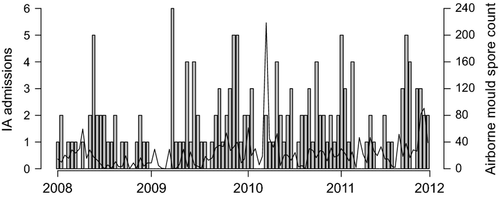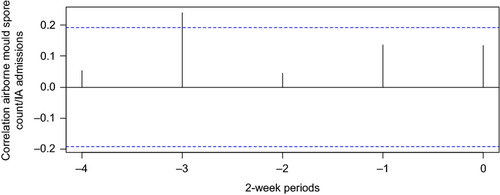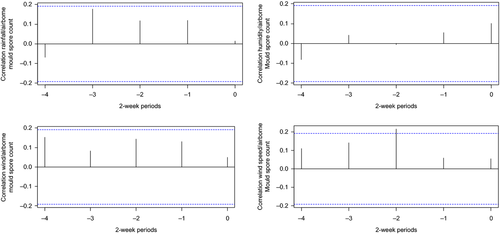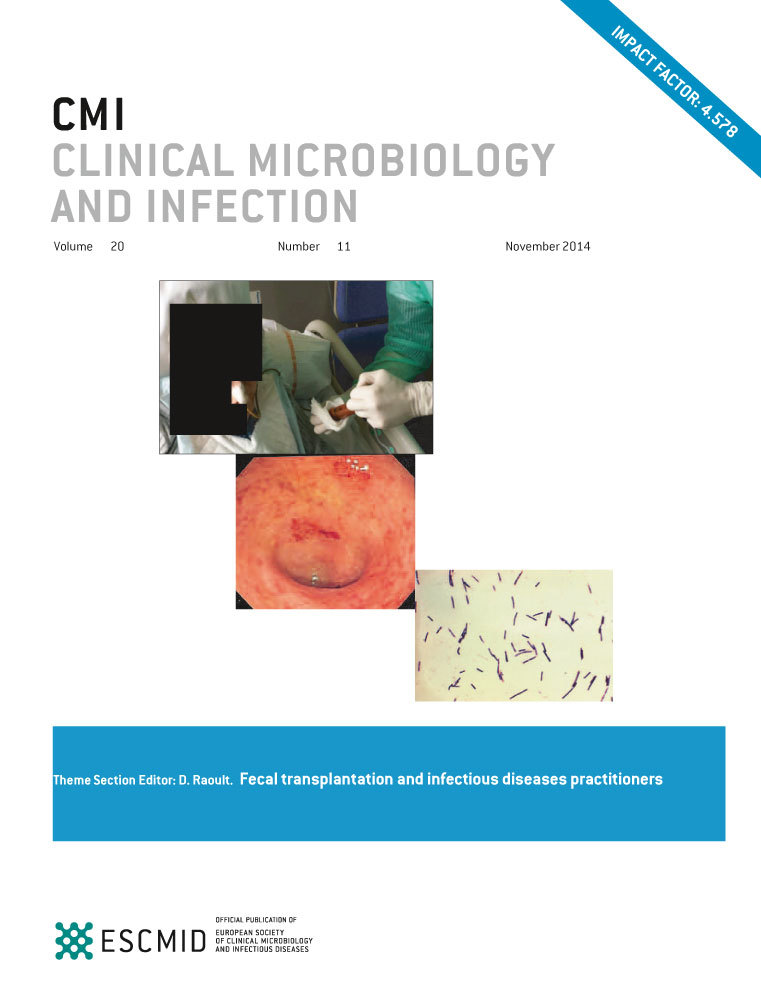Environmental variables associated with an increased risk of invasive aspergillosis
Abstract
Information on the environmental variables that may affect the incidence of invasive aspergillosis (IA) is scarce. We sought to determine the relationship between airborne spore counts, climatic conditions and IA. We also examined whether circulating respiratory viruses predispose patients to IA in a multicentre cohort study of hospitalized adults with IA. Data on environmental mould spores, climatic conditions and circulating respiratory viruses were obtained from the Environmental Department of the Autonomous University of Barcelona, the Meteorological Service of Catalonia and the Acute Respiratory Infection Surveillance Project in Catalonia, respectively. Between 2008 and 2011, 165 patients with IA were identified. Diagnosis was based on one or more of the following: culture (125 cases), galactomannan antigen (98) and histology (34). One hundred and twenty-seven cases (77%) had criteria for probable IA and the remainder for proven IA. Environmental mould spore counts from the period 28–42 days preceding infection presented significant associations with admissions due to IA. None of the climatic conditions were associated with an increased risk of IA, but the presence of circulating respiratory viruses was associated with a higher risk of infection: the most strongly associated viruses were respiratory syncytial virus, influenza A(H1N1)pdm09 and adenovirus. In conclusion, the presence of high numbers of spores in the air increases the risk of admission due to IA. Circulating respiratory viruses appear to be associated with a higher risk of developing IA. Physicians should be aware of this association in order to optimize prevention and diagnosis strategies for IA during viral epidemic periods.
Introduction
Invasive aspergillosis (IA) is a life-threatening infection that affects mainly severely immunocompromised patients. Despite advances in diagnosis and treatment, mortality rates associated with IA range from 40 to 90% 1, 2. More detailed knowledge of factors contributing to the pathogenesis of invasive aspergillosis is needed in order to optimize the management of this infection and to improve prophylactic measures.
The development of IA is a multistage process that begins with the inhalation of conidia dispersed in the air and continues with the host response against infection 3, 4. Individual host factors that increase the risk of infection have been well defined 5-7. However, our understanding of the natural history of infection, the inocula required and the incubation period of the disease are still poorly understood. In particular, information regarding the possible effect of certain environmental factors on the risk of IA is scarce. A previous study showed that climatic conditions may influence the airborne spore count in some geographical areas 8. However, the relationship between climatic conditions, airborne spore counts and rates of admission due to IA is less clear. It is tempting to speculate that circulating respiratory viruses may hinder the host response to infection. It could be related to an increased risk of IA.
We sought to identify the relationship between airborne mould spore count in the community and hospital admissions due to IA. We also aimed to assess the effect of climatic variables on airborne spore counts and/or the risk of IA in our area, and whether circulating respiratory viruses predispose patients to IA.
Methods
Setting, patients and study design
We performed a retrospective multicentre study of all episodes of invasive aspergillosis occurring in hospitalized adult patients between January 2008 and December 2011 at three tertiary teaching institutions in Barcelona, Spain. Only outpatients hospitalized for newly developed signs or symptoms of IA have been included. All haematological severely immunocompromised patients stayed in rooms with strict HEPA filtration. Patients who developed IA were identified by assessment of clinical, microbiology and pathology records, and by review of the diagnostic codes on hospital discharge. Only patients with proven and probable IA in accordance with the definitions of the European Organization for Research and Treatment of Cancer/National Institute of Allergy and Infectious Diseases Mycosis Study Group (EORTC/MSG) 9 were included. The following information was carefully collected from medical records: demographic characteristics, clinical features and day of IA diagnosis (the day on which the first diagnostic test was performed). For patients whose diagnosis was obtained from post-mortem examination, the day of death was considered to be the day of diagnosis.
This observational study was approved by the Institutional Review Board.
Environmental data
Daily median airborne mould concentrations were calculated from environmental data collected from the Institute of Environmental Science and Technology at the Autonomous University of Barcelona. The estimations were based on continuous measurements taken in the centre of the city. Data on climatic conditions were obtained from the Catalan Meteorological Service and were based on continuous measurements taken at the weather station in our urban area. Daily median records for rainfall, measured in litres/m2, humidity, wind and wind speed were used for the analysis. Data on circulating respiratory viruses were obtained from the acute respiratory infection surveillance project in Catalonia (PIRIDAC). The numbers of cases of influenza A, influenza B, adenovirus and respiratory syncytial virus (RSV) were used for the study.
Statistical analysis
Categorical variables were described using counts and percentages. Continuous variables were expressed as the mean and standard deviation or median and interquartile range depending on the Kolmogorov-Smirnov test.
Patients admitted for IA were recorded according to cases occurring during 2-week periods. The effect of environmental variables in each 2-week period was analysed. The Spearman ρ correlation was used to detect significant temporal associations between groups. For the analysis of quantitative associations between environmental mould spores and admissions due to IA in a 2-week period, a Poisson regression model was used. To assess potential confounding by environmental variables, we performed a multivariate analysis. A partial Spearman ρ correlation analysis and a Poisson relation with addition covariants were performed. The results were analysed using SPSS version 15.0 (SPSS Inc., Chicago, IL, USA). Statistical significance was established at α = 0.05. All reported p-values are two-tailed.
Results
General features of the study population
During the 4 years of the study period, 165 patients with IA were hospitalized. The most frequent co-morbid conditions were haematological malignancies (67 cases; 40.6%, including 13 stem cell transplantations), solid organ transplantation (33 cases; 20%), solid cancer (14 cases; 8.4%) and AIDS (nine cases; 5.4%). Other factors predisposing to IA were neutropenia (49 cases; 29.7%), corticosteroid use (87 cases, 52.7%) and use of other immunosuppressive drugs (97 cases; 58.8%). The diagnosis of IA was established by using one or more of the following methods: culture (125 cases), galactomannan (98 cases) and histology (34 cases). One hundred and twenty-seven cases (77%) had criteria for probable IA. Most cases were caused by Aspergillus fumigatus (78.4%), followed by A. flavus (7.3%), A. terreus (4.2%) and A. niger (3.6%). Table 1 summarizes the major epidemiological and clinical characteristics of the patients.
| Characteristic | Patients, n = 165 | % |
|---|---|---|
| Age, median years (IQR) | 61 (50–68) | – |
| Male sex | 104 | 63 |
| Underlying disease | ||
| Haematological malignancy | 67 | 40.6 |
| Solid organ transplant | 33 | 20 |
| Haematopoietic stem cell transplant | 13 | 7.9 |
| Solid tumour | 14 | 8.4 |
| AIDS | 9 | 5.4 |
| Immunodeficiency disorder | 5 | 3.0 |
| Othera | 12 | 7.3 |
| Immunological riskb | ||
| Neutropenia | 49 | 29.7 |
| Corticosteroid therapy | 87 | 52.7 |
| Any immunosuppressive therapy | 97 | 58.8 |
| Infection site | ||
| Pulmonary only | 150 | 90.9 |
| Disseminated IA | 15 | 9.1 |
| Diagnosisb | ||
| Culturec | 125 | 75.7 |
| Galactomannan | 98 | 59.4 |
| Biopsy or autopsy | 34 | 20.6 |
| Type of IA | ||
| Proven | 38 | 23.0 |
| Probable | 127 | 77.0 |
- a Contains patients with severe immunosuppressive treatment, mainly high dose of corticosteroids.
- b Patients could have >1 characteristic within a category.
- c A. fumigatus, 78.4%; A. niger, 3.6%; A. terreus, 4.2%; A. flavus, 7.3%.
Relationship between admission due to IA and environmental airborne spore count in 2-week periods
The distribution of admissions for IA and the environmental airborne spore count during the study period are shown in Fig. 1. Environmental mould spore counts in the third 2-week period (from 28 to 42 days) preceding infection presented significant associations with the occurrence of IA (Spearman ρ correlation 0.241; p 0.014), as shown in Fig. 2. Table 2 shows the quantitative relation between airborne spore count and admission due to IA in the overall cohort. The presence of environmental airborne mould spores increased the risk of IA admission 6.021 times after the third 2-week period. This correlation was statistically significant. We explored confounding with multivariate analysis but no effect was observed.


Climatic conditions, spore counts and admission for IA
Fig. 3 shows the relationship between climatic conditions and environmental airborne spore counts. No associations were found between precipitation, humidity and wind and the increase or decrease in mould spore counts in our environment in the next four 2-week periods. A relationship was found between higher wind speed and increased environmental spore count after the second 2-week period (Spearman ρ correlation 0.217; p 0.027). A second analysis did not show any association between any climatic conditions and admissions for IA in the next four 2-week periods. We explored confounding with multivariate analysis but no effect was observed.

Circulating respiratory viruses, spore counts and admission for IA
The presence of circulating respiratory viruses was not associated with an increase or decrease in environmental airborne mould spore counts in the next four 2-week periods. However, the existence of circulating respiratory viruses was associated with an increase in admissions due to IA (Fig. 4). The relationship was particularly strong during circulating influenza A(H1N1)pdm09 virus, adenovirus and RSV. The circulation of influenza A(H1N1)pdm09 virus was associated with increased hospital admissions for IA from the beginning of the virus circulation, in the first 2-week period and until the second 2-week period (Spearman's ρ correlation 0.304, p 0.002; 0.386, p < 0.001; 0.286, p 0.003, respectively). Adenovirus was associated with an increase in hospital admissions due to IA during the circulation of the virus and the subsequent 2-week period (Spearman's ρ correlation 0.238, p 0.015, and 0.236, p 0.016). RSV was also associated with higher admission for IA in the current period of circulating virus (Spearman's ρ correlation 0.242, p 0.013). No temporal relationship was found between circulating influenza A (different than H1N1) or influenza B and admissions due to IA.

In a second analysis, we examined the quantitative relationship between airborne spore count and admission for IA in periods with circulating respiratory viruses. Table 2 shows the most significant results of a Poisson regression model. The higher the ratio, the fewer the spores required for infection. As a summary, the airborne spore load required to produce admission for IA was very low during the first 2-week period of circulation of respiratory viruses. This high correlation was also significant and strong during the first 2-week periods of influenza A, B and influenza A(H1N1)pdm09. This correlation was also observed in the third 2-week period after circulating adenovirus.
| Quantitative relationship between airborne spore count and IA admission | p | |
|---|---|---|
| Overall cohort | ||
| First 2-week period preceding infection | 3.717 | 0.119 |
| Second 2-week period preceding infection | 1.522 | 0.593 |
| Third 2-week period preceding infection | 6.021 | 0.004 |
| All circulating virus periods | ||
| First 2-week period preceding infection | 61.333 | 0.001 |
| Second 2-week period preceding infection | −50.162 | 0.145 |
| Third 2-week period preceding infection | −75.521 | 0.163 |
| Circulating influenza A virus (non-H1N1) | ||
| First 2-week period preceding infection | 55.322 | 0.003 |
| Second 2-week period preceding infection | −42.953 | 0.190 |
| Third 2-week period preceding infection | −81.296 | 0.152 |
| Circulating influenza A(H1N1)pdm09 | ||
| First 2-week period preceding infection | 19.610 | 0.018 |
| Second 2-week period preceding infection | 3.066 | 0.734 |
| Third 2-week period preceding infection | 11.337 | 0.180 |
| Circulating influenza B virus | ||
| Current period of infection | 56.880 | 0.038 |
| First 2-week period preceding infection | −23.745 | 0.422 |
| Second 2-week period preceding infection | 12.368 | 0.668 |
| Circulating adenovirus | ||
| First 2-week period preceding infection | 1.275 | 0.684 |
| Second 2-week period preceding infection | −1.399 | 0.714 |
| Third 2-week period preceding infection | 4.789 | 0.047 |
| Circulating respiratory syncytial virus period | ||
| First 2-week period preceding infection | 0.996 | 0.756 |
| Second 2-week period preceding infection | −1.671 | 0.667 |
| Third 2-week period preceding infection | 4.529 | 0.063 |
- Poisson regression coefficient. This table details that the presence of environmental airborne mould spores increases the risk of IA admission 6.021 times after the third 2-week period (from 28 to 42 days) in the overall cohort. This correlation is statistically significant. Moreover, the table also shows the number of spores required for infection. The higher the ratio, the fewer the spores required for infection. Remarkably, the airborne spore load required to produce admission for IA was very low during the first 2-week period of circulation of respiratory viruses. This high correlation was also significant and strong during the first 2-week periods of influenza A, B and pandemic A (H1N1). This correlation was also observed in the third 2-week period after circulating adenovirus.
Discussion
This multicentre study of a large number of hospitalized adults with IA found a relationship between certain environmental factors and the risk of IA. Specifically, a high airborne mould spore count in the period from 28 to 42 days prior to infection was correlated with higher rates of IA diagnosis. We did not find an association between environmental spore count and climatic variables in our area, or between climatic conditions and IA admissions. Finally, we recorded a strong relationship between circulating respiratory viruses and risk of IA.
The results of our study coincide with those of previous studies that have documented the relationship between environmental mould spore counts and IA 8, 10. These findings support the notion that a substantial proportion of patients with IA acquired the infection outside the hospital. The incubation period of IA has not been well defined and is probably highly variable, depending on the inhaled inocula and host characteristics. In our cohort, which included a mix of patients with a highly varied immunity status, we found a strong relationship between IA admissions and high spore counts from 28 to 42 days before the diagnosis of infection. These data suggest that the interaction between Aspergillus and the host begins several days prior to the current diagnosis of IA. Establishing more prompt diagnosis of IA remains a challenge.
Climatic conditions may affect the epidemiology of bacterial, viral and fungal infections 11, 12. The relationship is affected by the impact of the weather on the prevalence or virulence of the pathogen, or by changes in host behaviours. Panackal et al. 8 reported that climatic conditions in Seattle affected spore counts and increased IA rates in a cohort of patients who received haematopoietic stem cell transplants. However, they were unable to demonstrate this association in Houston, an area with a very different climate. In our geographical area, climatic conditions were not associated with changes in airborne spore counts and/or with IA. This finding suggests that the pathogenesis of IA is complex and that geographical differences should be taken into consideration. Moreover, the relationship between climatic conditions and environmental spore counts may be biased by other factors such as air pollution, land use and other modifying factors that are difficult to assess.
Interestingly, circulating respiratory viruses were associated with an increased risk of IA. During circulating respiratory virus periods we found that a lower airborne mould spore load was required for IA to occur. Moreover, time to report spore inhalation and IA was shorter, in spite of the absence of any relationship between circulating respiratory viruses and environmental airborne mould spore count. It is tempting to speculate that respiratory viruses produce a major variation in host susceptibility. It has been reported that current infection with parainfluenza 3, RSV or influenza increases the patient's risk of developing IA 5, 13-15. Respiratory viruses alter the bronchial mucosa, and the resulting epithelial disruption facilitates fungal invasion. Moreover, viruses may affect local and systemic host defences, producing a state of host adaptive immune deficiency and facilitating the pathogenesis of Aspergillus 3.
Our study suggests that the relationship between respiratory viral infection and IA is significant. Therefore, the implementation of effective diagnostic, treatment and prevention strategies for viral infections in severely immunosuppressed patients is of paramount importance. Primarily, a routine search for common respiratory viruses in all immunosuppressed patients complaining of symptoms of respiratory tract infection should be performed. Prompt treatment with oseltamivir or ribavirin when needed might help to diminish the incidence of IA. Finally, lifelong seasonal influenza vaccination with inactivated influenza vaccine appears to be the most effective strategy. However, the efficacy of vaccines may be compromised in this population due to insufficient antigenic response. Further information is needed in order to improve vaccine strategies in immunocompromised patients. Another important measure to reduce the viral load in the immunosuppressed host environment is the vaccination of healthcare personnel and family members against influenza early in the season 16, 17. Optimizing hospital or home isolation measures against viral infection, diminishing patient visits or increasing antifungal prophylaxis in more severe immunosuppressed patients during circulating respiratory virus periods should be considered.
The strengths of the current study include its inclusion of a large cohort of consecutive hospitalized patients with IA, the comprehensive data collection and the prospective collection of environmental variables. Nevertheless, there are several limitations that should be acknowledged. Firstly, this is an observational study and residual confounding cannot be ruled out. Moreover, due to its retrospective design, potential biases in the selection of patients can not totally be ruled out. Secondly, our study showed indirect evidence between viral infection and IA admissions. It should be noted, however, that we did not demonstrate a direct proof of a causal association between an acute viral disease of the respiratory tract and IA. To demonstrate the direct relationship between the virus and the IA, a prospective study of a cohort of patients with high risk of IA should be performed. All patients should be routinely tested for respiratory viruses in order to avoid under-diagnosis of viral infection. Multivariate analysis comparing environmental effects, host variables, underlying disease and time-dependent variables, including among others duration and dosage of steroid therapy, other immunosuppressive treatments, neutropenia, cytomegalovirus reactivation and presence of severe graft-vs-host disease, would be needed. To our knowledge, this study has not been performed yet. Thirdly, the study was carried out in a specific geographical area. As noted above, the impact of environmental variables on other areas may be different. Moreover, we did not find a relationship between climatic conditions and IA. It should be noted, however, that data from Seattle have demonstrated a high incidence of IA occurring just after seasonal periods of low precipitation and high temperatures, which coincide with high environmental spore counts. Fourthly, it is difficult to determine the impact of multiple variables that may affect the risk of IA, especially those related to host-immunity; our cohort of patients with IA had different host and prevention strategies applied. Finally, IA is a complex disease and it is difficult to interpret time-to-event. There may be wide variations in incidence or diagnosis depending on population, diagnostic approach or prophylactic measures.
In summary, a high airborne mould spore count in the environment increases the risk of IA admission in the following 28–42 days. This finding supports the idea that most IAs are acquired outside the hospital. Circulating respiratory viruses appear to be associated with an increased risk of developing IA. Physicians should be aware of this association in order to optimize the prevention and diagnosis strategies for IA during viral epidemic periods.
Funding and Acknowledgements
This study was supported by research grants from the Ministerio de Sanidad y Consumo, Instituto de Salud Carlos III (FIS 10/01318), ESCMID Research grant 2013, and Ministerio de Ciencia e Innovación, Instituto de Salud Carlos III – co-financed by the European Development Regional Fund ‘A way to achieve Europe’ ERDF, Spanish Network for the Research in Infectious Diseases (REIPI RD06/0008). Dr Garcia-Vidal is the recipient of a Juan de la Cierva research grant from the Instituto de Salud Carlos III, Madrid, Spain. Part of these results was presented at ICAAC 2012 in San Francisco.
Transparency Declaration
The authors have no conflicts of interest to declare.




